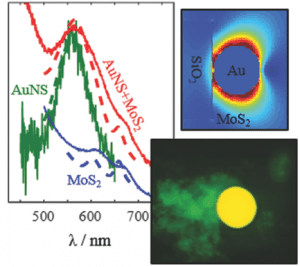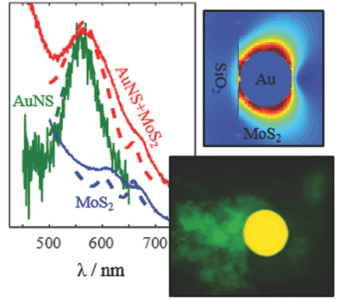 There is growing interest in hybrid nanomaterial platforms for next-generation optoelectronic devices that consist of two-dimensional transition metal dichalcogenides (TMD) decorated by plasmonic nanoparticles. TMD characteristics like strong light absorption/emission, nonlinear optical activity, and transistor switching performance make them an inviting candidate to bridge photonics and electronics. Exfoliation of bulk crystals to obtain TMD monolayers alters their electronic band structure, inducing a crossover from indirect-gap behavior to a tunable direct bandgap.
There is growing interest in hybrid nanomaterial platforms for next-generation optoelectronic devices that consist of two-dimensional transition metal dichalcogenides (TMD) decorated by plasmonic nanoparticles. TMD characteristics like strong light absorption/emission, nonlinear optical activity, and transistor switching performance make them an inviting candidate to bridge photonics and electronics. Exfoliation of bulk crystals to obtain TMD monolayers alters their electronic band structure, inducing a crossover from indirect-gap behavior to a tunable direct bandgap.
Adding plasmonic nanoparticles to monolayer TMD-based flexible photodetectors, photocatalysts, and solar cells has demonstrably improved their performance, ostensibly by coupling incident and inherent electromagnetic modes. Description and further development of such hybrid prototypes, however, has been constrained by limited availability of relevant experimentally-validated, compact models to examine energy coupling and enhance understanding of resonant optical and electronic interactions.
Forcherio and Roper at the University of Arkansas used an approximate discrete dipole (DDA) solution to Maxwell’s equations to distinguish the origin and energetics of spectral features supported in nanoparticle-TMD monolayer hybrids. Resonant energy losses in monolayer molybdenum disulfide (MoS2), a semiconductive graphene analog, decorated with gold and silver nanoparticles of spherical and triangular geometries were measured spectroscopically.
The probable extent of hot electron transport efficiency between the nanoparticles and MoS2 was estimated by comparing results with DDA simulations to quantify energy transfer by known optical and thermal dissipation pathways. Introduction and experimental-validation of DDA provides a new approach to advance understanding, design, and development of nanoparticle-TMD interfaces which optimize optoelectronic activity of hybrid nanomaterial platforms.

















